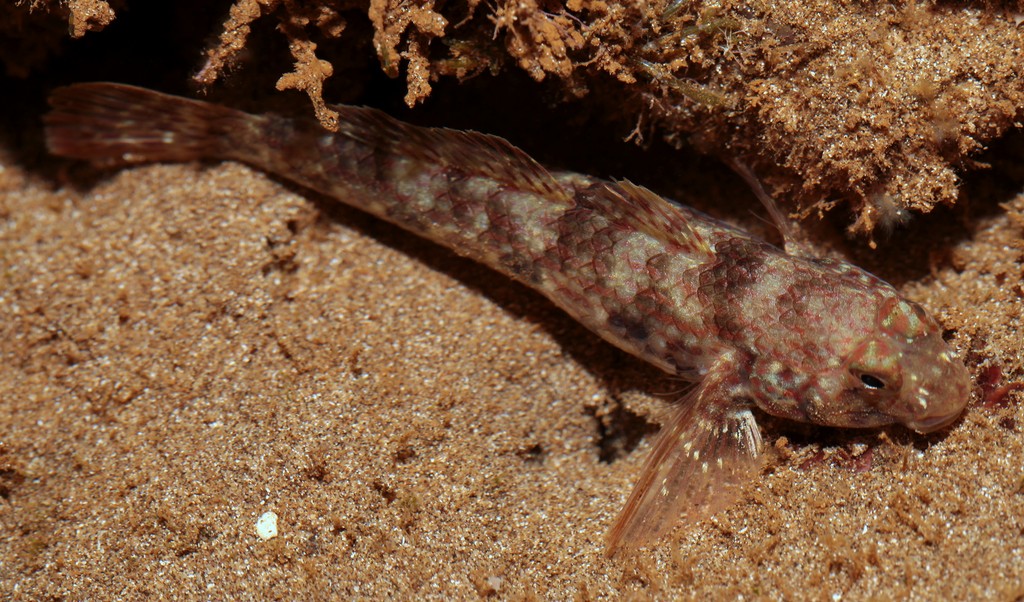ISTIGOBIUS ORNATUS - (RUPPELL, 1830)
Actinopterygii (Gigaclass) > Actinopteri (Class) > Teleostei (Subclass) > Gobiiformes (Order) > Gobioidei (Suborder) > Gobiidae (Family) > Gobiinae (Subfamily) > Istigobius (Genus)
Gobie orné, Oorlaide dikkop, Ornate goby, Ornate sand goby, Korutokko, Kazarihaze,
Synonymes
Acentrogobius ornatus (Rüppell, 1830)
Ctenogobius calderae (Evermann & Seale, 1906)
Gobius calderae (Evermann & Seale, 1906)
Gobius ehrenbergii (Valenciennes, 1837)
Gobius elegans (Valenciennes, 1837)
Gobius interstinctus (Richardson, 1844)
Gobius ornatus (Rüppell, 1830)
Gobius periophthalmoides (Bleeker, 1851)
Gobius stephensoni (Whitley, 1932)
Gobius thurstoni (Day, 1888)
Gobius ventralis (Valenciennes, 1837)
Gobius venustulus (Fowler, 1904)
Istigobius elegans (Valenciennes, 1837)
Istigobius stephensoni (Whitley, 1932)
Rhinogobius calderae (Evermann & Seale, 1906)
Sicyopterus maritimus (Fourmanoir, 1955)
----------------------------------------------
Description
Dorsal spines (total): 7; Dorsal soft rays (total): 10-12; Anal spines: 1; Anal soft rays: 9 - 11; Vertebrae: 26. Upper 3-4 pectoral fin rays free. Body color pale gray; operculum with 5 small blue spots interspersed with brownish red spots; 5 vertical rows of white spots on pectoral fins; anterior tip of first dorsal fin bright yellow. 4th spine of 1st dorsal fin longest. Predorsal scales cycloid, trunk ctenoid. Mouth with overhanging snout, lips greatly thickened. Cheeks and operculae without scales. Female pelvic and anal fins not as darkly pigmented as in male. Also with terete body shape, slightly depressed; eyes situated dorso-laterally; reduced swim bladders. Max length : 11.0 cm. Depth range 0 - 5 m.
Etymology
Istigobius: Greek, istios = sail + Latin, gobius = gudgeon.
ornatus: from Latin, orno = adorned, decorated.
Original description: Gobius ornatus Rüppell, 1830 - Locality type: Massaua, Red Sea.
Distribution
Indo-Pacific: Red Sea south to northern Mozambique and east to Fiji, north to southern Taiwan, south to New Caledonia. Recently recorded from Tonga.
Biology
A common species that inhabits mangroves and silty, rocky areas; occasionally found in rubble reef areas. Only single individuals were observed; many individuals found scattered over a small area. Found primarily in lower estuaries, usually in mangroves. This is the species of the genus that is found farthest inland. Feeds on small invertebrates. Genital papilla, of male varying from lightly to heavily pigmented and terminating to side of anal spine. Female genital papilla lightly pigmented and truncate, terminating well before anal spine. Benthic spawner.
Similar species
Fishes in the genera Bathygobius can be easily confused with those of Istigobius. The main difference is the overhanging snout in Istigobius. Bathygobius has larger elongate dark spots on the midside and numerous small white spots (Istigobius has white lines, but no spots). Istigobius tends to have brighter colours, with Bathygobius being black, brown and white.
Gobie orné, Oorlaide dikkop, Ornate goby, Ornate sand goby, Korutokko, Kazarihaze,
Synonymes
Acentrogobius ornatus (Rüppell, 1830)
Ctenogobius calderae (Evermann & Seale, 1906)
Gobius calderae (Evermann & Seale, 1906)
Gobius ehrenbergii (Valenciennes, 1837)
Gobius elegans (Valenciennes, 1837)
Gobius interstinctus (Richardson, 1844)
Gobius ornatus (Rüppell, 1830)
Gobius periophthalmoides (Bleeker, 1851)
Gobius stephensoni (Whitley, 1932)
Gobius thurstoni (Day, 1888)
Gobius ventralis (Valenciennes, 1837)
Gobius venustulus (Fowler, 1904)
Istigobius elegans (Valenciennes, 1837)
Istigobius stephensoni (Whitley, 1932)
Rhinogobius calderae (Evermann & Seale, 1906)
Sicyopterus maritimus (Fourmanoir, 1955)
----------------------------------------------
Description
Dorsal spines (total): 7; Dorsal soft rays (total): 10-12; Anal spines: 1; Anal soft rays: 9 - 11; Vertebrae: 26. Upper 3-4 pectoral fin rays free. Body color pale gray; operculum with 5 small blue spots interspersed with brownish red spots; 5 vertical rows of white spots on pectoral fins; anterior tip of first dorsal fin bright yellow. 4th spine of 1st dorsal fin longest. Predorsal scales cycloid, trunk ctenoid. Mouth with overhanging snout, lips greatly thickened. Cheeks and operculae without scales. Female pelvic and anal fins not as darkly pigmented as in male. Also with terete body shape, slightly depressed; eyes situated dorso-laterally; reduced swim bladders. Max length : 11.0 cm. Depth range 0 - 5 m.
Etymology
Istigobius: Greek, istios = sail + Latin, gobius = gudgeon.
ornatus: from Latin, orno = adorned, decorated.
Original description: Gobius ornatus Rüppell, 1830 - Locality type: Massaua, Red Sea.
Distribution
Indo-Pacific: Red Sea south to northern Mozambique and east to Fiji, north to southern Taiwan, south to New Caledonia. Recently recorded from Tonga.
Biology
A common species that inhabits mangroves and silty, rocky areas; occasionally found in rubble reef areas. Only single individuals were observed; many individuals found scattered over a small area. Found primarily in lower estuaries, usually in mangroves. This is the species of the genus that is found farthest inland. Feeds on small invertebrates. Genital papilla, of male varying from lightly to heavily pigmented and terminating to side of anal spine. Female genital papilla lightly pigmented and truncate, terminating well before anal spine. Benthic spawner.
Similar species
Fishes in the genera Bathygobius can be easily confused with those of Istigobius. The main difference is the overhanging snout in Istigobius. Bathygobius has larger elongate dark spots on the midside and numerous small white spots (Istigobius has white lines, but no spots). Istigobius tends to have brighter colours, with Bathygobius being black, brown and white.
